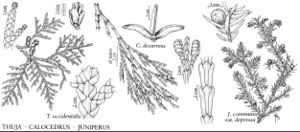Difference between revisions of "Juniperus communis var. depressa"
Fl. Amer. Sept. 2: 646. 1814.
GeoffLevin (talk | contribs) (Added Nunavut to distribution; treatment was published before Nunavut split from N.W.T.) |
GeoffLevin (talk | contribs) m (Fixed Nfld. and Labr. distribution to match printed version.) |
||
| Line 32: | Line 32: | ||
|habitat=Rocky soil, slopes, and summits | |habitat=Rocky soil, slopes, and summits | ||
|elevation=0–2800 m | |elevation=0–2800 m | ||
| − | |distribution=Alta.;B.C.;Man.;N.B.;Nfld. and Labr. | + | |distribution=Alta.;B.C.;Man.;N.B.;Nfld. and Labr.;N.W.T.;N.S.;Nunavut;Ont.;P.E.I.;Que.;Sask.;Yukon;Alaska;Ariz.;Calif.;Colo.;Conn.;Ga.;Idaho;Ill.;Ind.;Maine;Mass.;Mich.;Minn.;Mont.;Nev.;N.H.;N.Mex.;N.Y.;N.C.;N.Dak.;Ohio;Oreg.;Pa.;R.I.;S.C.;S.Dak.;Utah;Vt.;Va.;Wash.;Wis.;Wyo. |
|discussion=<p>In the flora, larger individuals of this variety (to 10 m) have been misidentified as <i></i>var.<i> communis</i>.</p> | |discussion=<p>In the flora, larger individuals of this variety (to 10 m) have been misidentified as <i></i>var.<i> communis</i>.</p> | ||
|tables= | |tables= | ||
| Line 50: | Line 50: | ||
|habitat=Rocky soil, slopes, and summits | |habitat=Rocky soil, slopes, and summits | ||
|elevation=0–2800 m | |elevation=0–2800 m | ||
| − | |distribution=Alta.;B.C.;Man.;N.B.;Nfld. and Labr. | + | |distribution=Alta.;B.C.;Man.;N.B.;Nfld. and Labr.;N.W.T.;N.S.;Nunavut;Ont.;P.E.I.;Que.;Sask.;Yukon;Alaska;Ariz.;Calif.;Colo.;Conn.;Ga.;Idaho;Ill.;Ind.;Maine;Mass.;Mich.;Minn.;Mont.;Nev.;N.H.;N.Mex.;N.Y.;N.C.;N.Dak.;Ohio;Oreg.;Pa.;R.I.;S.C.;S.Dak.;Utah;Vt.;Va.;Wash.;Wis.;Wyo. |
|reference=None | |reference=None | ||
|publication title=Fl. Amer. Sept. | |publication title=Fl. Amer. Sept. | ||
Latest revision as of 21:11, 20 February 2024
Shrubs prostrate or low with ascending branchlet tips (occasionally spreading shrubs to 3 m, rarely small trees to 10 m). Leaves upturned, to 15 × 1.6 mm, rarely spreading, linear, glaucous stomatal band about as wide as each green marginal band, apex acute and mucronate to acuminate. Seed cones 6–9 mm, shorter than leaves. 2n = 22.
Habitat: Rocky soil, slopes, and summits
Elevation: 0–2800 m
Distribution
Alta., B.C., Man., N.B., Nfld. and Labr., N.W.T., N.S., Nunavut, Ont., P.E.I., Que., Sask., Yukon, Alaska, Ariz., Calif., Colo., Conn., Ga., Idaho, Ill., Ind., Maine, Mass., Mich., Minn., Mont., Nev., N.H., N.Mex., N.Y., N.C., N.Dak., Ohio, Oreg., Pa., R.I., S.C., S.Dak., Utah, Vt., Va., Wash., Wis., Wyo.
Discussion
In the flora, larger individuals of this variety (to 10 m) have been misidentified as var. communis.
Selected References
None.
